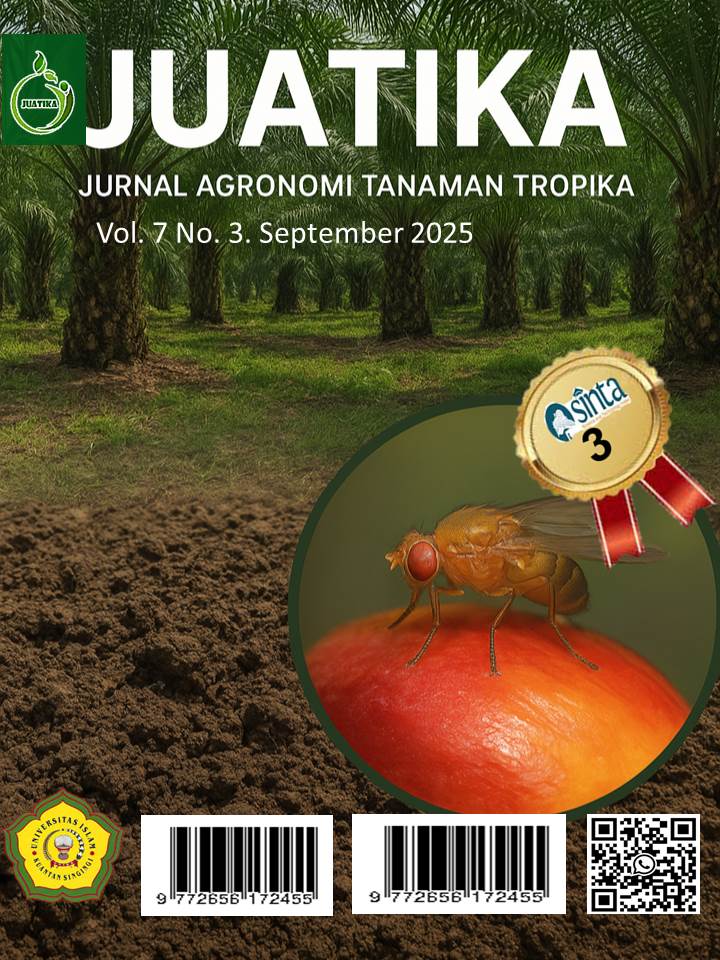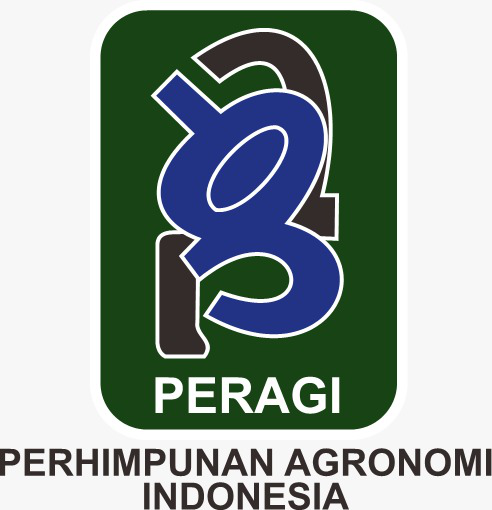Response of Glutinous Corn (Zea mays var. Ceratina Kulesh) to Organic Fertilizer Application on Acidic Dry Land
Abstract
Acidic drylands are classified as suboptimal lands due to their low soil fertility, characterized by poor nutrient content, low organic matter, poor soil structure, and inadequate drainage. Glutinous corn is one of the corn varieties susceptible to acidic dryland conditions, although some varieties exhibit greater tolerance. This study aims to evaluate the effects of various types of organic fertilizers on acidic drylands and on the growth and yield of glutinous corn (Zea mays var. Ceratina Kulesh). The study was conducted at Jl. Sukarela, Km 7, Sukarame District, Palembang City, using a field experiment with a non-factorial Randomized Block Design (RBD) consisting of four treatments, each replicated six times. The treatments included: no organic fertiliser, chicken manure fertiliser (30 tons/ha), liquid organic fertiliser from vegetable waste (20 mL/L), and a combination of chicken manure fertiliser with vegetable waste POC. The parameters observed were plant height, number of leaves, cob length, cob weight per plant, cob weight per plot, dry stalk weight per plot, and weight of 100 seeds. The results showed an increase in soil fertility, as indicated by improved soil structure and a rise in soil pH from 5.3 to 6.5. The liquid organic fertiliser from vegetable waste, at a dose of 20 ml/L, was the most effective treatment, with an average cob weight per plant of 240.3 g (equivalent to 1.28 tons/ha).
Downloads
References
Afiyah, D. N., Uthari, E., Widyabudiningsih, D., & Jayanti, R. D. (2021). Pembuatan dan pengujian pupuk organik cair (POC) dari limbah pasar dengan menggunakan bioaktivator EM4. Fullerene Journal of Chemistry, 6(2), 89–95. https://doi.org/10.37033/fjc.v6i2.325
Azrul, Mahmud, Y., & Istina, I. N. (2023). Pengaruh dosis kotoran walet terhadap pertumbuhan dan produksi tanaman jagung (Zea mays L.) pada tanah Podsolik Merah Kuning. Prosiding Seminar Nasional Ketahanan Pangan, 1, 138–154.
Chasanah, N., Purnamasari, R. T., Arifin, A. Z., & et al. (2018). Pengaruh konsentrasi pupuk organik cair terhadap pertumbuhan dan hasil tanaman jagung manis (Zea mays saccharata Sturt.). Jurnal Agroteknologi Merdeka Pasuruan, 2(2), 1–7.
Elfianis, R. (2020). Syarat tumbuh tanaman jagung. Agrotek.id. https://agrotek.id/syarat-tumbuh-tanaman-jagung
Febrianna, M., Prijono, S., & Kusumarini, N. (2018). Pemanfaatan pupuk organik cair untuk meningkatkan serapan nitrogen serta pertumbuhan dan produksi sawi (Brassica juncea L.) pada tanah berpasir. Jurnal Tanah dan Sumberdaya Lahan, 5(2), 2549–793. http://jtsl.ub.ac.id https://doi.org/10.21776/ub.jtsl.2025.012.2
Hakim, N. (2006). Pengelolaan kesuburan tanah masam dengan teknologi pengapuran terpadu. Andalas University Press. https://onesearch.id/Record/IOS3196.slims-3158
Lamakoma, C. R., Patty, J. R., & Amba, M. (2019). Pengaruh pupuk organik cair dan pupuk majemuk terhadap pertumbuhan dan produksi jagung ketan (Zea mays var. ceratina). Jurnal Budidaya Pertanian, 15(2), 127–133. https://doi.org/10.30598/jbdp.2019.15.2.127
Mahdiannoor, & Nurul Istiomah, S. (2016). Aplikasi pupuk organik cair terhadap pertumbuhan dan hasil tanaman jagung manis. Gastronomía Ecuatoriana y Turismo Local, 1(69), 5–24.
Murdaningsih, M. (2020). Aplikasi pupuk organik cair dari limbah pasar pada tanaman sawi (Brassica juncea L.). Agrica, 13(1), 57–67. https://doi.org/10.37478/agr.v13i1.379
Nazira, A., Hera, N., & Irfan, M. (2023). Pemberian pupuk cair nutritan dengan beberapa konsentrasi terhadap pertumbuhan dan hasil jagung (Zea mays L.). Prosiding Seminar Nasional Integrasi Pertanian dan Peternakan, 1(1), 147–154.
Pratikta, D., Hartatik, S., & K. W. (2013). Pengaruh penambahan pupuk NPK terhadap produksi beberapa aksesi tanaman jagung (Zea mays L.). Berkala Ilmiah Pertanian, 1(2), 19–21.
Puspadewi, S., Sutari, W., & Kusumiyati, K. (2016). Pengaruh konsentrasi pupuk organik cair (POC) dan dosis pupuk N, P, K terhadap pertumbuhan dan hasil tanaman jagung manis (Zea mays L. var. rugosa Bonaf.) kultivar talenta. Kultivasi, 15(3), 208–216. https://doi.org/10.24198/kultivasi.v15i3.11764
Sulaeman, Y., Maswar, & Erfandi, D. (2017). Pengaruh kombinasi pupuk organik dan anorganik terhadap sifat kimia tanah dan hasil tanaman jagung di lahan kering masam. Pengkajian dan Pengembangan Teknologi Pertanian.
Syofia, I., Munar, A., & Sofyan, M. (2014). Pengaruh pupuk organik cair terhadap pertumbuhan dan hasil dua varietas tanaman jagung manis (Zea mays saccharata Sturt.). Agrium, 18(3), 208–218.
Thamrin, N., & Hama, S. (2022). Pengaruh pupuk kandang ayam terhadap pertumbuhan vegetatif tanaman jagung (Zea mays L.). Sains dan Teknologi, 1(4).
Tuhuteru, S. (2018). Efektivitas hara makro dan mikro terhadap pertumbuhan tanaman jagung (Zea mays L.). Jurnal Agroekoteknologi, 10(1), 65–73. https://doi.org/10.21776/ub.jtsl.2023.010.1
Tansidi, A., Idham, I., & Syamsiar, S. (2023). Pengaruh pupuk kandang ayam terhadap pertumbuhan dan produksi tanaman jagung pulut (Zea mays ceratina L.). Agrotekbis: E-Jurnal Ilmu Pertanian, 11(5), 1190–1198. https://doi.org/10.22487/agrotekbis.v11i5.1875
Wahyudin, A., Fitriatin, B. N., Wicaksono, F. Y., Ruminta, R., & Aristiyo, M. (2017). Respons tanaman jagung (Zea mays L.) akibat pemberian pupuk fosfat dan waktu aplikasi pupuk hayati mikroba pelarut fosfat pada Ultisols Jatinangor. Kultivasi, 16(1), 246–254. https://doi.org/10.24198/kltv.v16i1.11559
Yanuarius, F., Nurhadiah, & Mangardi. (2025). Pemberian pupuk organik cair (POC) limbah sayur terhadap pertumbuhan dan hasil jagung ketan (Zea mays ceratina). Jurnal PIPER, 21(1). https://doi.org/10.51826/piper.v21i1.1587
Yuliarti, N. (2009). 1001 cara menghasilkan pupuk organik. Yogyakarta: Lyli Publisher. https://opac.perpusnas.go.id/DetailOpac.aspx?id=860187
Copyright (c) 2025 Maria Lusia, Ika Paridawati, Neni Marlina, Novrizal Syahrir, Susiana, Nurrohma, Haperidah Nunihlawati

This work is licensed under a Creative Commons Attribution 4.0 International License.
Authors who publish with Jurnal Agronomi Tanaman Tropika (JUATIKA) agree to the following terms:
Authors retain copyright and grant the Jurnal Agronomi Tanaman Tropika (JUATIKA) right of first publication with the work simultaneously licensed under a Creative Commons Attribution License (CC BY 4.0) that allows others to share (copy and redistribute the material in any medium or format) and adapt (remix, transform, and build upon the material for any purpose, even commercially) with an acknowledgment of the work's authorship and initial publication in Jurnal Agronomi Tanaman Tropika (JUATIKA).
Authors are able to enter into separate, additional contractual arrangements for the non-exclusive distribution of the journal's published version of the work (e.g., post it to an institutional repository or publish it in a book), with an acknowledgment of its initial publication in Jurnal Agronomi Tanaman Tropika (JUATIKA). Authors are permitted and encouraged to post their work online (e.g., in institutional repositories or on their website) prior to and during the submission process, as it can lead to productive exchanges, as well as earlier and greater citation of published work.







 More Information
More Information



